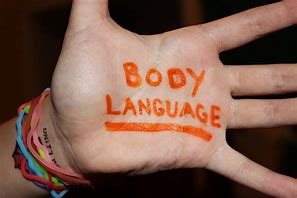Show, Don't Tell - part V by giraffmang |

The use of body language: It is vital in your stories that the reader can identify, on some level, with the main characters. It doesn’t matter who or what they are, they must be relatable. If the reader isn’t invested in the characters, what is there to keep them reading on to find out what happens to them? If the reader isn’t invested, it won’t matter how action-packed the story is, or how many twists and turns it has. It will fall flat as the reader won’t care. A good way to establish that reader-character connection is through the use of body language. Try to avoid using emotion words (sad, happy, angry, and so on) as this relies on the reader being told and not being engaged in a direct manner. The use of a character’s physicality can bring their experiences to life on the page. Below follows some examples of conveying different things through body language. In each example, the first sentence is action-orientated through body language. The second is basic telling. Arthur suppressed the urge to roll his eyes. Arthur was annoyed. ‘That’s hilarious,’ Helen said, without smiling. ‘That’s hilarious,' Helen said sarcastically. ‘I wish I’d enough money to write you all a check,’ Ingrid said. She placed her palms flat on the table, leant forward and looked each one of them in the eye. ‘I wish I’d enough money to write you all a check,’ Ingrid said, hoping her family believed her. In order to get into the habit of using body language to convey emotion, it’s a good idea to create a ‘cheat sheet’ for yourself. Write a list of feelings and ways in which they could physically manifest themselves. Remember, though, not to overdo it and become repetitive and always bear your character in mind. Here's a few examples: Afraid – character breaks into a cold sweat, shrinking back, trembling, widening of the eyes, freezing, change in pallor, quickening of breath. Angry – reddening of the face, white knuckles, jaw clenching, quick or sharp gestures, stomping, shouting, narrowing of the eyes. Bored – fidgeting, looking off into space, sighing, yawning. Sad – hunched over, crying, unable to eat, dragging feet, frowning, withdrawn. Many writers use both show and tell when utilising body language – ‘her eyes widened in shock’ – but try to let the physical attributes do the work for you as much as you can. It’s more rewarding for the reader. In doing so, you guide the reader’s inferences, while also giving them room to interpret and identify with your characters in their own way. Remember, showing illustrates, while telling jumps straight to the facts. Try This. Write a basic conversation between two characters — such as a character asking someone about their day at work, or two people deciding what to cook for dinner. Instead of focusing on dialogue to reveal the characters’ emotions or feelings, tell the story via body language. Are the characters flirting? Is there frostiness between them? Is one of them on the verge of tears or hiding something from the other? Use body language to layer in this subtext.
|
| ©
Copyright 2025.
giraffmang
All rights reserved. giraffmang has granted FanStory.com, its affiliates and its syndicates non-exclusive rights to display this work. |



